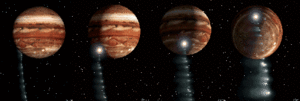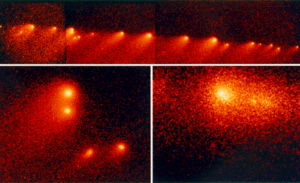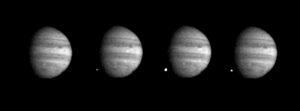
|
| ©NASA JPL |
Latest Images of Comet Shoemaker-Levy
News Flash (Last Updated March 14, 2000)
* NASA Renames NEAR Spacecraft For Planetary Science Pioneer Gene Shoemaker (NASA - March 14, 2000)
* New CDROMs With Comet Shoemaker-Levy 9 Data Available (Goddard Space Flight Center - July 29, 1999)
* Moon Burial For Eugene Shoemaker (BBC News - July 28, 1999)
* Eugene Shoemaker Ashes Carried on Lunar Prospector (University of Arizona - January 7, 1998)
* Eugene Shoemaker (1928-1997) (Brian Marsden - July 18, 1997)
* Chain of Impact Craters Suggested by Spaceborne Radar Images (NASA - March 20, 1996).
* Comet SL9 Home Page Tops 7 Million Accesses (March 1, 1996).
* Hubble Observes Comet SL9 Effects on Jupiter (February 22-23, 1996).
* Pic du Midi Images of Jupiter (February 3, 1996).
* New Galileo Jupiter Animations Available (JPL - February 2, 1996).
* Comet Schwassmann-Wachmann 3 Splits Again (Sky & Telescope - February 2, 1996).
* Galileo Probe Science Results (NASA - January 22, 1996).
Background Information

|
| ©NASA JPL |
Comet Shoemaker-Levy 9, torn into pieces as a result of a close approach to Jupiter in July 1992, will collide with Jupiter during the third week of July 1994. Of tremendous scientific importance, the impacts of the cometary fragments will release more energy into Jupiter's atmosphere than that of the world's combined nuclear arsenals. Because the impacts will occur on the night side of Jupiter, the explosions will not be directly observable from Earth. However, professional and amateur astronomers may observe the impact light flashes reflected off the inner satellites of Jupiter. Any lasting effects on Jupiter, such as atmospheric clouds, ejecta plumes, or seismic thermal disturbances, may be observable an hour or so later when the rotation of Jupiter brings the impact sites into Earth's view.
Analysis of high-resolution images of the comet taken by the NASA's Hubble Space Telescope in July 1993 suggests that the major cometary fragments range in size from one to a few kilometers. The large fragments are embedded in a cloud of debris with material ranging in size from boulder-sized to microscopic particles. Although comet-like outgassing of the fragments has not been observed, the fragile nature of the object suggests that it is indeed a comet rather than a more compact asteroid.
Comet Shoemaker-Levy 9 was the ninth short-periodic comet discovered by Eugene and Carolyn Shoemaker and David Levy. It was first detected on a photograph taken on the night of March 24, 1993 with the 0.4-meter Schmidt telescope on Palomar Mountain in California. Subsequent observations were forthcoming from observers at the University of Hawaii, the Spacewatch telescope on Kitt Peak in Arizona and McDonald Observatory in Texas. These observations were used to demonstrate that the comet was in orbit about Jupiter, and had made a very close approach (within 1.4 Jupiter radii from Jupiter's center) on July 7, 1992. During this close approach, the unequal Jupiter gravitational attractions on the comet's near and far sides broke apart the fragile object. The disruption of a comet into multiple fragments is an unusual event, the capture of a comet into an orbit about Jupiter is even more unusual, and the collision of a large comet with a planet is an extraordinary, millennial event.
* Comet Freight Train to Collide with Jupiter.
* The Probability of Collisions with Earth.
* The K-T Event.
* Planetary Spacecraft as Observers.
* Comet Team Biographies.
Latest Conclusions of the Comet Collision

|
| ©NASA JPL |
This page lists a series of articles on the preliminary conclusions that have been drawn so far on the Comet Shoemaker-Levy 9 collision with Jupiter.
Published Papers about Comet Shoemaker-Levy 9 (May 1995).
Proceedings from ESO SL9-Jupiter Workshop (March 1995).
* Report of the Near-Earth Objects Survey Working Group (June 1995).
* A Comet's Fiery Dance at Jupiter (Galileo Messenger - May 1995).
* Abstracts from IAU Colloquium 156 (May 1995).
* Summary of European SL-9/Jupiter Workshop (Postcript file only) (ESO - February 1995).
* Talk given by Amara Graps at the MacWorld Expo in January 1995.
* The Brilliant Death of Comet SL9 (JPL - December 1994).
* Update on SL9/Jupiter Collision (Richard West - December 15, 1994).
* Galileo Comet SL9 Observations (JPL - October 31, 1994).
* Summary of Comet Day Poster Session (Mark Boslough - October 1994)
* The Great Dark Spots of Jupiter (Sky & Telescope - November 1994).
* Hubble Observations Shed New Light on Jupiter Collision (NASA - September 29, 1994).
* ESO Messenger Article (September 1994).
* http://www2.jpl.nasa.gov/sl9/uni1.html (JPL - July 29, 1994).
Images, Images, Images (1444 Images, 64 Observatories)
* Top 20 Comet SL9 Images
* Most Recent Comet SL9 Images
* Images Sorted By Observatory
* Images Sorted By Fragment Impact
* Miscellaneous Images
Animations
Comet Shoemaker-Levy Impact Times
* Impact Times for SL9 (Chodas & Yeomans - March 18, 1995).
* Impact Times for SL9 (Calar Alto - October 25, 1994).
* Post-Crash Impact Times for SL9 (Chodas & Yeomans - August 5, 1994).
* Lastest Table of Impact Times for the remaining comet fragments from Chodas, Yeomans (July 20, 1994).
* Predicted Impact Times of the Lost Fragments (July 11, 1994)
* Best Viewing Locations for the Impacts (June 25, 1994)
* Earth Facing Views of Each Impact.
* Likelihood of Fireball Visibility.
TV Coverage
* Discovery Channel
* NASA TV
* PBS
* CNN
Spacecraft Observations of the Impacts
* Galileo
* Hubble Space Telescope
* Voyager 2
* Ulysses
* International Ultraviolet Explorer (IUE)
* Extreme Ultraviolet Explorer (EUVE)
* Roentgensatellit (ROSAT)
* NASA Sounding Rocket
Ground Based Observations
* Jet Propulsion Laboratory
* Caltech
* Cerro Tololo Interamerican Observatory
* Comet Impact Network Experiment
* Deep Space Network
* European Southern Observatory
* Griffith Observatory
* Infrared Telescope Facility
* IUE Observatory.
* Keck Telescope
* Kitt Peak National Observatory
* Kuiper Airborne Observatory
* Lawrence Livermore National Laboratory
* Lick and Leuschner Observatories
* Lowell Observatory
* McDonald Observatory
* Mount Stromlo and Siding Spring Observatories
* Mt. Wilson Observatory
* National Radio Astronomy Observatory, Very Large Array (VLA)
* National Solar Observatory
* Owens Valley Radio Observatory
* Project BAMBI Amateur Radio Telescope
* South Africa Astronomical Observatory
* Space Telescope Science Institude (STScI)
* University of Hawaii
* University of Oregon
* University of Rochester
* Whately Observatory
Links to Other Comet Shoemaker-Levy Home Pages
* Comet/Jupiter Collision Frequently Asked Questions Home Page (Texas A&M).
* Comet Shoemaker-Levy 9 Bulletin Board (University of Maryland).
* Comet Shoemaker-Levy 9 Collision with Jupiter Home Page (GSFC).
* EUVE/Comet Shoemaker-Levy Home Page (University of California, Berkeley).
* Computer Simulations of the Jupiter-Comet Collision (MIT).
* Shoemaker-Levy9/Jupiter Collision (European Southern Observatory).
* Comet Shoemaker-Levy Home Page (Pittsburgh Supercomputing Center).
JPL Homepage
Please direct questions and comments about this page to Ron Baalke
ron@jpl.nasa.gov



Reader Comments
to our Newsletter